Child Development: A Critical Study of Theories and Their Application
VerifiedAdded on 2023/06/13
|7
|1918
|405
AI Summary
This article provides a critical study of child development theories and their application in understanding the emotional, physical, spiritual and cognitive behaviour of a child. It includes a case study of a three-year-old girl named Ruby and how her behaviour can be linked to various theories of development.
Contribute Materials
Your contribution can guide someone’s learning journey. Share your
documents today.
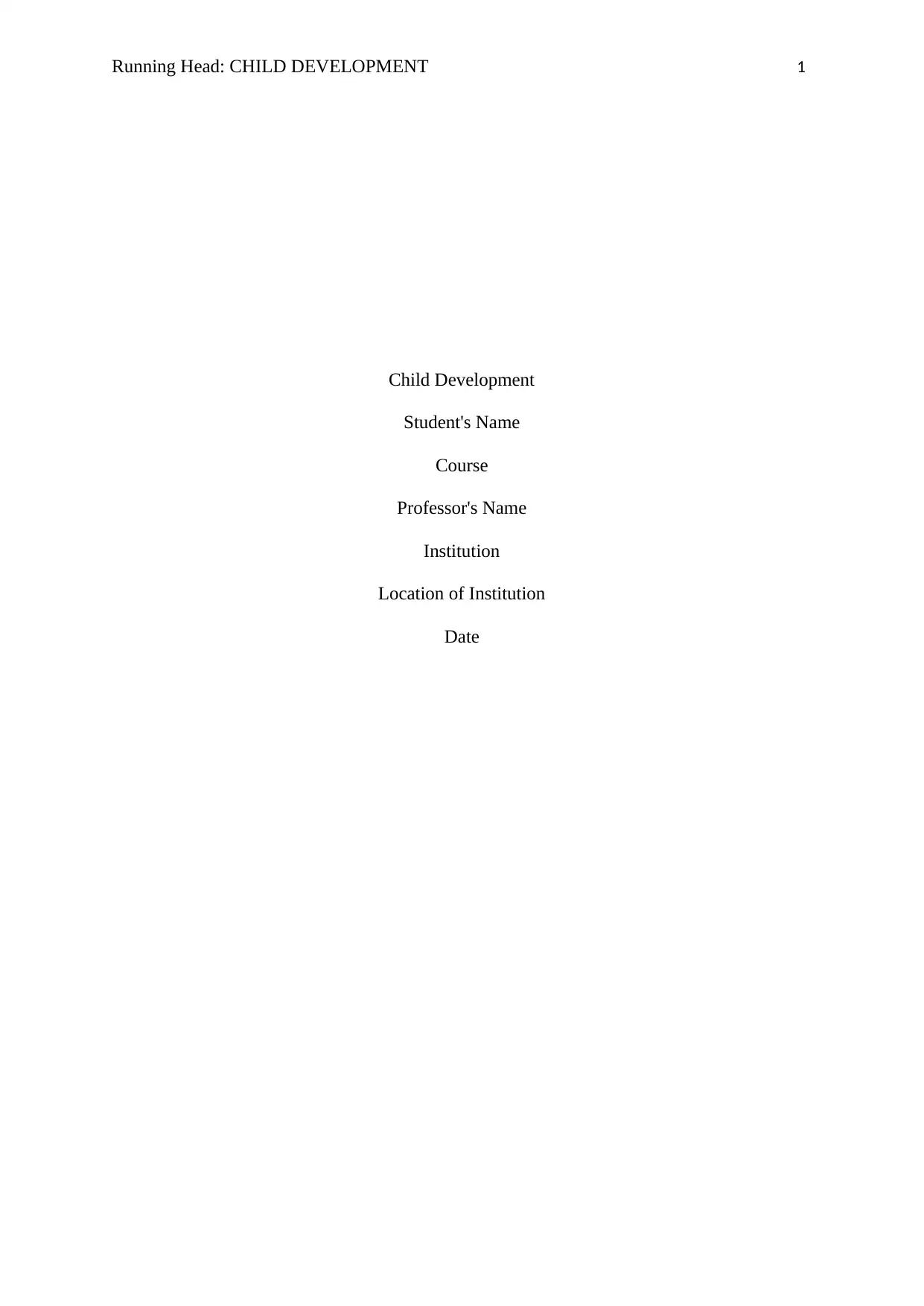
Running Head: CHILD DEVELOPMENT 1
Child Development
Student's Name
Course
Professor's Name
Institution
Location of Institution
Date
Child Development
Student's Name
Course
Professor's Name
Institution
Location of Institution
Date
Secure Best Marks with AI Grader
Need help grading? Try our AI Grader for instant feedback on your assignments.
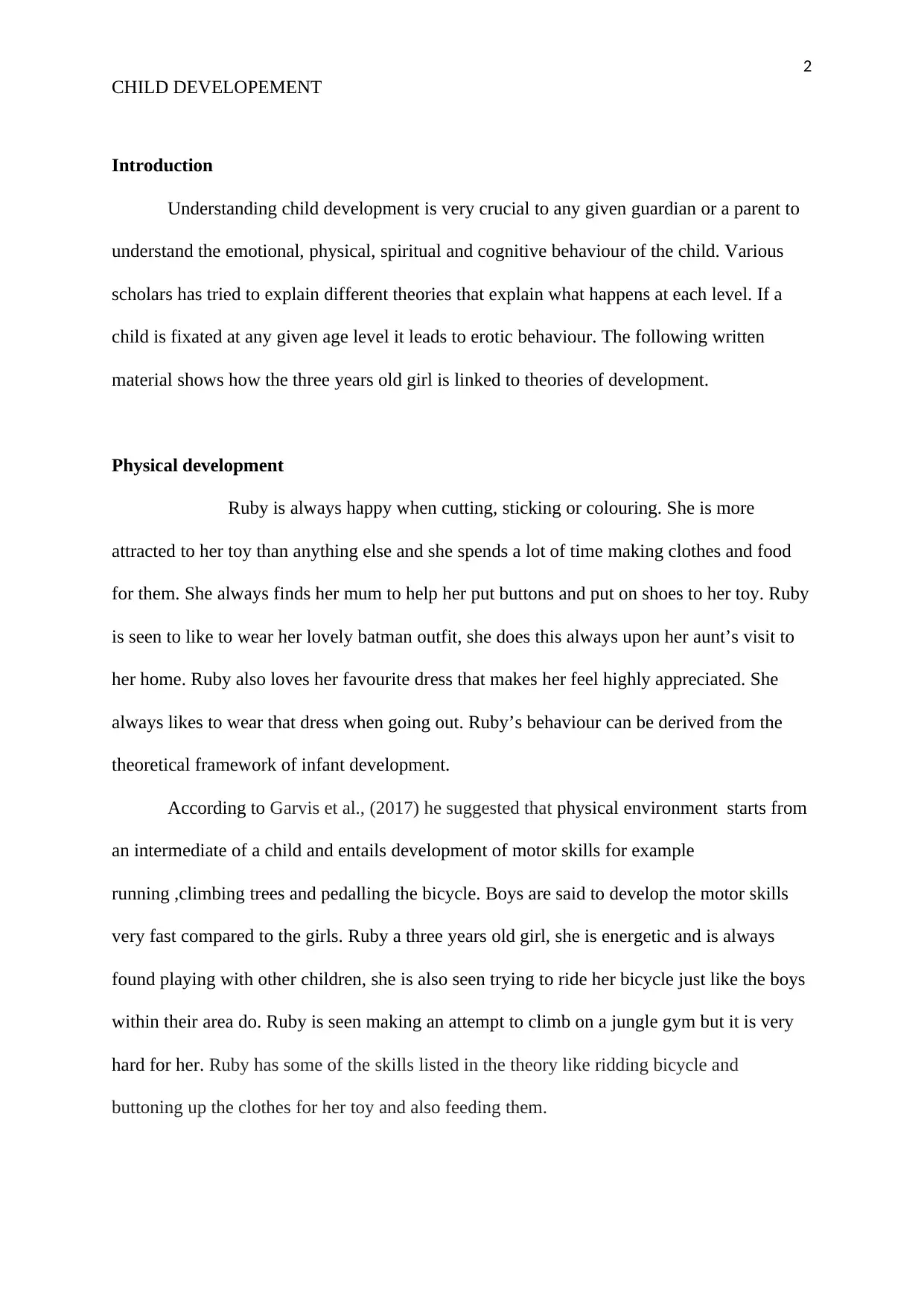
2
CHILD DEVELOPEMENT
Introduction
Understanding child development is very crucial to any given guardian or a parent to
understand the emotional, physical, spiritual and cognitive behaviour of the child. Various
scholars has tried to explain different theories that explain what happens at each level. If a
child is fixated at any given age level it leads to erotic behaviour. The following written
material shows how the three years old girl is linked to theories of development.
Physical development
Ruby is always happy when cutting, sticking or colouring. She is more
attracted to her toy than anything else and she spends a lot of time making clothes and food
for them. She always finds her mum to help her put buttons and put on shoes to her toy. Ruby
is seen to like to wear her lovely batman outfit, she does this always upon her aunt’s visit to
her home. Ruby also loves her favourite dress that makes her feel highly appreciated. She
always likes to wear that dress when going out. Ruby’s behaviour can be derived from the
theoretical framework of infant development.
According to Garvis et al., (2017) he suggested that physical environment starts from
an intermediate of a child and entails development of motor skills for example
running ,climbing trees and pedalling the bicycle. Boys are said to develop the motor skills
very fast compared to the girls. Ruby a three years old girl, she is energetic and is always
found playing with other children, she is also seen trying to ride her bicycle just like the boys
within their area do. Ruby is seen making an attempt to climb on a jungle gym but it is very
hard for her. Ruby has some of the skills listed in the theory like ridding bicycle and
buttoning up the clothes for her toy and also feeding them.
CHILD DEVELOPEMENT
Introduction
Understanding child development is very crucial to any given guardian or a parent to
understand the emotional, physical, spiritual and cognitive behaviour of the child. Various
scholars has tried to explain different theories that explain what happens at each level. If a
child is fixated at any given age level it leads to erotic behaviour. The following written
material shows how the three years old girl is linked to theories of development.
Physical development
Ruby is always happy when cutting, sticking or colouring. She is more
attracted to her toy than anything else and she spends a lot of time making clothes and food
for them. She always finds her mum to help her put buttons and put on shoes to her toy. Ruby
is seen to like to wear her lovely batman outfit, she does this always upon her aunt’s visit to
her home. Ruby also loves her favourite dress that makes her feel highly appreciated. She
always likes to wear that dress when going out. Ruby’s behaviour can be derived from the
theoretical framework of infant development.
According to Garvis et al., (2017) he suggested that physical environment starts from
an intermediate of a child and entails development of motor skills for example
running ,climbing trees and pedalling the bicycle. Boys are said to develop the motor skills
very fast compared to the girls. Ruby a three years old girl, she is energetic and is always
found playing with other children, she is also seen trying to ride her bicycle just like the boys
within their area do. Ruby is seen making an attempt to climb on a jungle gym but it is very
hard for her. Ruby has some of the skills listed in the theory like ridding bicycle and
buttoning up the clothes for her toy and also feeding them.
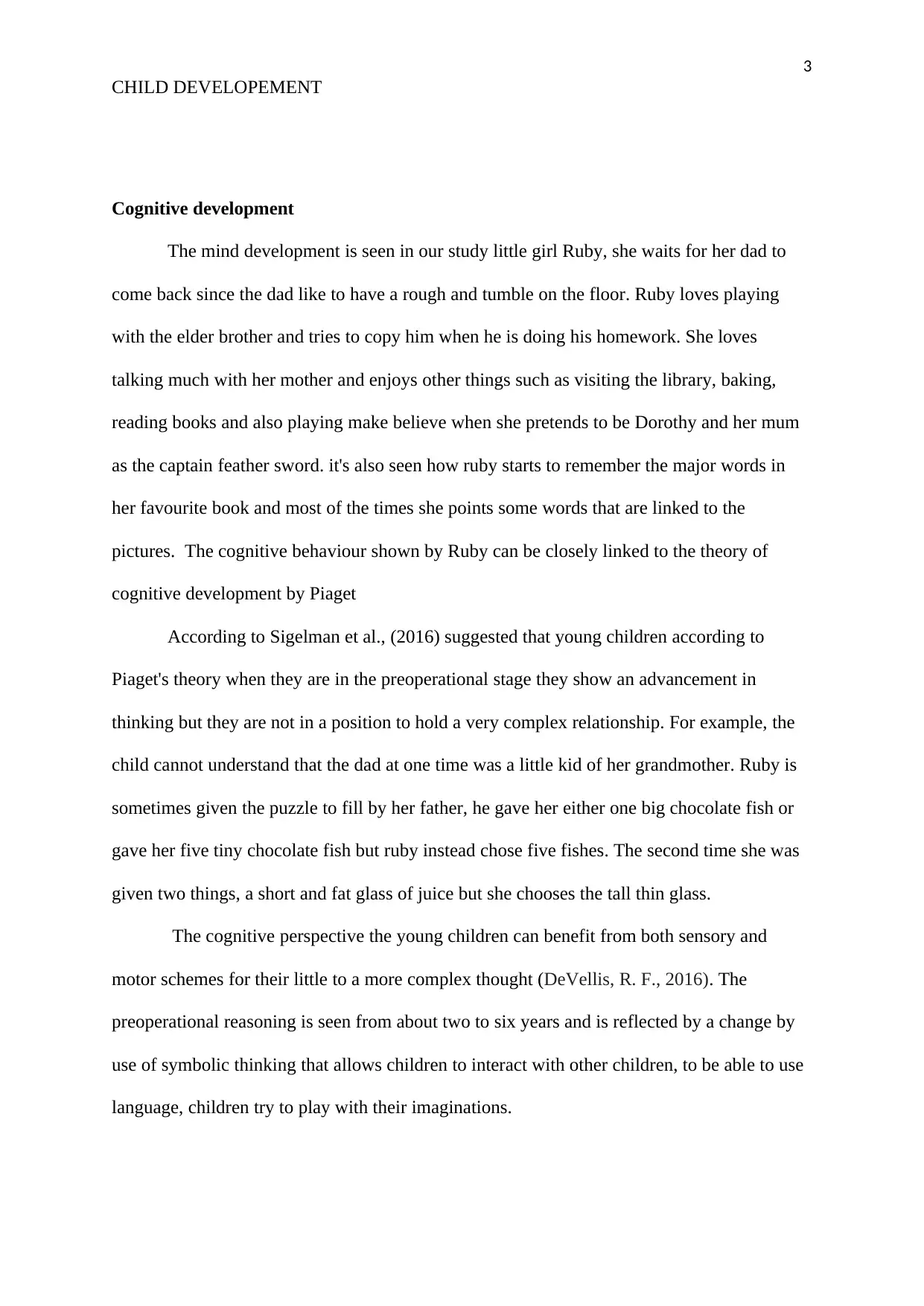
3
CHILD DEVELOPEMENT
Cognitive development
The mind development is seen in our study little girl Ruby, she waits for her dad to
come back since the dad like to have a rough and tumble on the floor. Ruby loves playing
with the elder brother and tries to copy him when he is doing his homework. She loves
talking much with her mother and enjoys other things such as visiting the library, baking,
reading books and also playing make believe when she pretends to be Dorothy and her mum
as the captain feather sword. it's also seen how ruby starts to remember the major words in
her favourite book and most of the times she points some words that are linked to the
pictures. The cognitive behaviour shown by Ruby can be closely linked to the theory of
cognitive development by Piaget
According to Sigelman et al., (2016) suggested that young children according to
Piaget's theory when they are in the preoperational stage they show an advancement in
thinking but they are not in a position to hold a very complex relationship. For example, the
child cannot understand that the dad at one time was a little kid of her grandmother. Ruby is
sometimes given the puzzle to fill by her father, he gave her either one big chocolate fish or
gave her five tiny chocolate fish but ruby instead chose five fishes. The second time she was
given two things, a short and fat glass of juice but she chooses the tall thin glass.
The cognitive perspective the young children can benefit from both sensory and
motor schemes for their little to a more complex thought (DeVellis, R. F., 2016). The
preoperational reasoning is seen from about two to six years and is reflected by a change by
use of symbolic thinking that allows children to interact with other children, to be able to use
language, children try to play with their imaginations.
CHILD DEVELOPEMENT
Cognitive development
The mind development is seen in our study little girl Ruby, she waits for her dad to
come back since the dad like to have a rough and tumble on the floor. Ruby loves playing
with the elder brother and tries to copy him when he is doing his homework. She loves
talking much with her mother and enjoys other things such as visiting the library, baking,
reading books and also playing make believe when she pretends to be Dorothy and her mum
as the captain feather sword. it's also seen how ruby starts to remember the major words in
her favourite book and most of the times she points some words that are linked to the
pictures. The cognitive behaviour shown by Ruby can be closely linked to the theory of
cognitive development by Piaget
According to Sigelman et al., (2016) suggested that young children according to
Piaget's theory when they are in the preoperational stage they show an advancement in
thinking but they are not in a position to hold a very complex relationship. For example, the
child cannot understand that the dad at one time was a little kid of her grandmother. Ruby is
sometimes given the puzzle to fill by her father, he gave her either one big chocolate fish or
gave her five tiny chocolate fish but ruby instead chose five fishes. The second time she was
given two things, a short and fat glass of juice but she chooses the tall thin glass.
The cognitive perspective the young children can benefit from both sensory and
motor schemes for their little to a more complex thought (DeVellis, R. F., 2016). The
preoperational reasoning is seen from about two to six years and is reflected by a change by
use of symbolic thinking that allows children to interact with other children, to be able to use
language, children try to play with their imaginations.
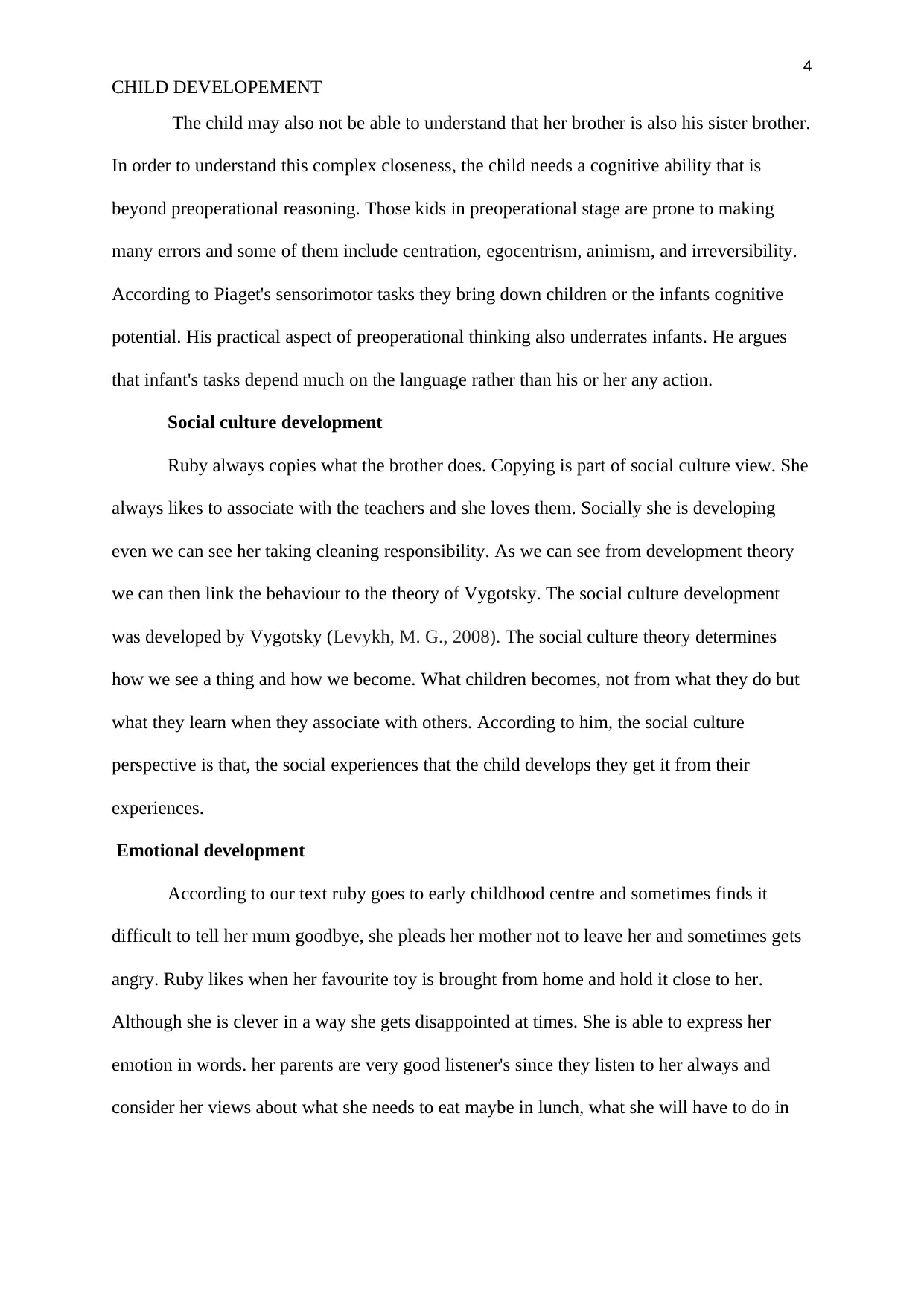
4
CHILD DEVELOPEMENT
The child may also not be able to understand that her brother is also his sister brother.
In order to understand this complex closeness, the child needs a cognitive ability that is
beyond preoperational reasoning. Those kids in preoperational stage are prone to making
many errors and some of them include centration, egocentrism, animism, and irreversibility.
According to Piaget's sensorimotor tasks they bring down children or the infants cognitive
potential. His practical aspect of preoperational thinking also underrates infants. He argues
that infant's tasks depend much on the language rather than his or her any action.
Social culture development
Ruby always copies what the brother does. Copying is part of social culture view. She
always likes to associate with the teachers and she loves them. Socially she is developing
even we can see her taking cleaning responsibility. As we can see from development theory
we can then link the behaviour to the theory of Vygotsky. The social culture development
was developed by Vygotsky (Levykh, M. G., 2008). The social culture theory determines
how we see a thing and how we become. What children becomes, not from what they do but
what they learn when they associate with others. According to him, the social culture
perspective is that, the social experiences that the child develops they get it from their
experiences.
Emotional development
According to our text ruby goes to early childhood centre and sometimes finds it
difficult to tell her mum goodbye, she pleads her mother not to leave her and sometimes gets
angry. Ruby likes when her favourite toy is brought from home and hold it close to her.
Although she is clever in a way she gets disappointed at times. She is able to express her
emotion in words. her parents are very good listener's since they listen to her always and
consider her views about what she needs to eat maybe in lunch, what she will have to do in
CHILD DEVELOPEMENT
The child may also not be able to understand that her brother is also his sister brother.
In order to understand this complex closeness, the child needs a cognitive ability that is
beyond preoperational reasoning. Those kids in preoperational stage are prone to making
many errors and some of them include centration, egocentrism, animism, and irreversibility.
According to Piaget's sensorimotor tasks they bring down children or the infants cognitive
potential. His practical aspect of preoperational thinking also underrates infants. He argues
that infant's tasks depend much on the language rather than his or her any action.
Social culture development
Ruby always copies what the brother does. Copying is part of social culture view. She
always likes to associate with the teachers and she loves them. Socially she is developing
even we can see her taking cleaning responsibility. As we can see from development theory
we can then link the behaviour to the theory of Vygotsky. The social culture development
was developed by Vygotsky (Levykh, M. G., 2008). The social culture theory determines
how we see a thing and how we become. What children becomes, not from what they do but
what they learn when they associate with others. According to him, the social culture
perspective is that, the social experiences that the child develops they get it from their
experiences.
Emotional development
According to our text ruby goes to early childhood centre and sometimes finds it
difficult to tell her mum goodbye, she pleads her mother not to leave her and sometimes gets
angry. Ruby likes when her favourite toy is brought from home and hold it close to her.
Although she is clever in a way she gets disappointed at times. She is able to express her
emotion in words. her parents are very good listener's since they listen to her always and
consider her views about what she needs to eat maybe in lunch, what she will have to do in
Secure Best Marks with AI Grader
Need help grading? Try our AI Grader for instant feedback on your assignments.
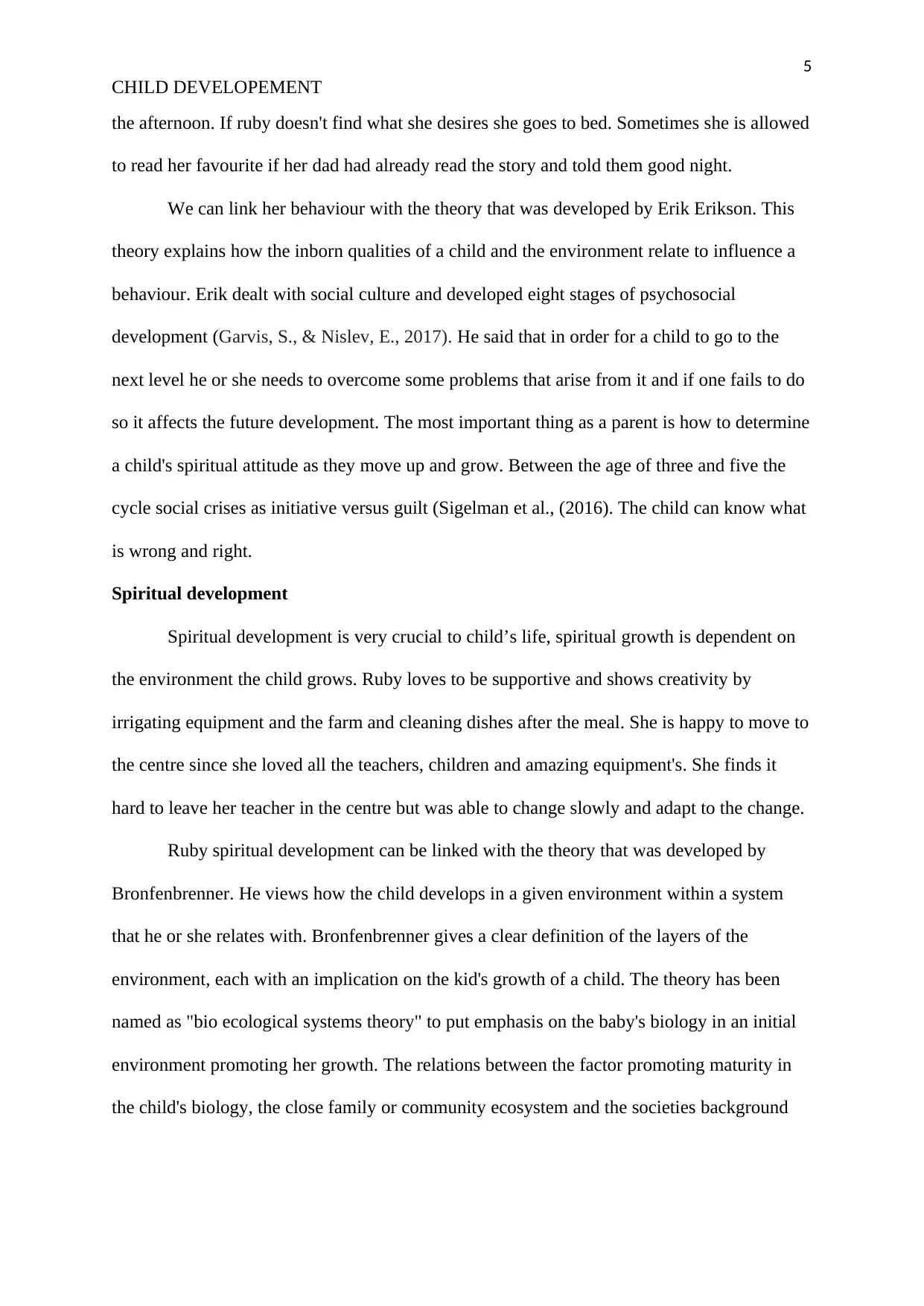
5
CHILD DEVELOPEMENT
the afternoon. If ruby doesn't find what she desires she goes to bed. Sometimes she is allowed
to read her favourite if her dad had already read the story and told them good night.
We can link her behaviour with the theory that was developed by Erik Erikson. This
theory explains how the inborn qualities of a child and the environment relate to influence a
behaviour. Erik dealt with social culture and developed eight stages of psychosocial
development (Garvis, S., & Nislev, E., 2017). He said that in order for a child to go to the
next level he or she needs to overcome some problems that arise from it and if one fails to do
so it affects the future development. The most important thing as a parent is how to determine
a child's spiritual attitude as they move up and grow. Between the age of three and five the
cycle social crises as initiative versus guilt (Sigelman et al., (2016). The child can know what
is wrong and right.
Spiritual development
Spiritual development is very crucial to child’s life, spiritual growth is dependent on
the environment the child grows. Ruby loves to be supportive and shows creativity by
irrigating equipment and the farm and cleaning dishes after the meal. She is happy to move to
the centre since she loved all the teachers, children and amazing equipment's. She finds it
hard to leave her teacher in the centre but was able to change slowly and adapt to the change.
Ruby spiritual development can be linked with the theory that was developed by
Bronfenbrenner. He views how the child develops in a given environment within a system
that he or she relates with. Bronfenbrenner gives a clear definition of the layers of the
environment, each with an implication on the kid's growth of a child. The theory has been
named as "bio ecological systems theory" to put emphasis on the baby's biology in an initial
environment promoting her growth. The relations between the factor promoting maturity in
the child's biology, the close family or community ecosystem and the societies background
CHILD DEVELOPEMENT
the afternoon. If ruby doesn't find what she desires she goes to bed. Sometimes she is allowed
to read her favourite if her dad had already read the story and told them good night.
We can link her behaviour with the theory that was developed by Erik Erikson. This
theory explains how the inborn qualities of a child and the environment relate to influence a
behaviour. Erik dealt with social culture and developed eight stages of psychosocial
development (Garvis, S., & Nislev, E., 2017). He said that in order for a child to go to the
next level he or she needs to overcome some problems that arise from it and if one fails to do
so it affects the future development. The most important thing as a parent is how to determine
a child's spiritual attitude as they move up and grow. Between the age of three and five the
cycle social crises as initiative versus guilt (Sigelman et al., (2016). The child can know what
is wrong and right.
Spiritual development
Spiritual development is very crucial to child’s life, spiritual growth is dependent on
the environment the child grows. Ruby loves to be supportive and shows creativity by
irrigating equipment and the farm and cleaning dishes after the meal. She is happy to move to
the centre since she loved all the teachers, children and amazing equipment's. She finds it
hard to leave her teacher in the centre but was able to change slowly and adapt to the change.
Ruby spiritual development can be linked with the theory that was developed by
Bronfenbrenner. He views how the child develops in a given environment within a system
that he or she relates with. Bronfenbrenner gives a clear definition of the layers of the
environment, each with an implication on the kid's growth of a child. The theory has been
named as "bio ecological systems theory" to put emphasis on the baby's biology in an initial
environment promoting her growth. The relations between the factor promoting maturity in
the child's biology, the close family or community ecosystem and the societies background
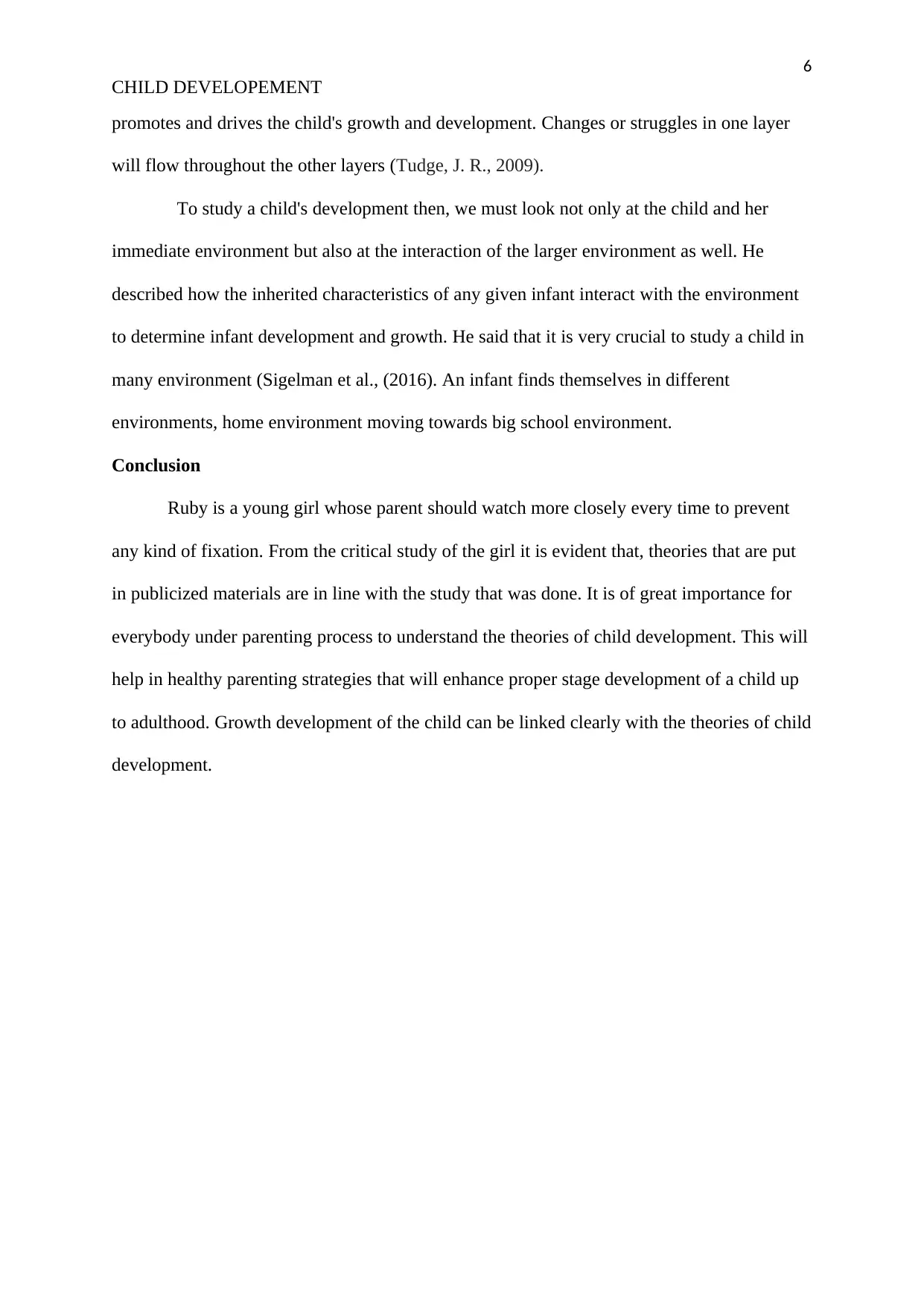
6
CHILD DEVELOPEMENT
promotes and drives the child's growth and development. Changes or struggles in one layer
will flow throughout the other layers (Tudge, J. R., 2009).
To study a child's development then, we must look not only at the child and her
immediate environment but also at the interaction of the larger environment as well. He
described how the inherited characteristics of any given infant interact with the environment
to determine infant development and growth. He said that it is very crucial to study a child in
many environment (Sigelman et al., (2016). An infant finds themselves in different
environments, home environment moving towards big school environment.
Conclusion
Ruby is a young girl whose parent should watch more closely every time to prevent
any kind of fixation. From the critical study of the girl it is evident that, theories that are put
in publicized materials are in line with the study that was done. It is of great importance for
everybody under parenting process to understand the theories of child development. This will
help in healthy parenting strategies that will enhance proper stage development of a child up
to adulthood. Growth development of the child can be linked clearly with the theories of child
development.
CHILD DEVELOPEMENT
promotes and drives the child's growth and development. Changes or struggles in one layer
will flow throughout the other layers (Tudge, J. R., 2009).
To study a child's development then, we must look not only at the child and her
immediate environment but also at the interaction of the larger environment as well. He
described how the inherited characteristics of any given infant interact with the environment
to determine infant development and growth. He said that it is very crucial to study a child in
many environment (Sigelman et al., (2016). An infant finds themselves in different
environments, home environment moving towards big school environment.
Conclusion
Ruby is a young girl whose parent should watch more closely every time to prevent
any kind of fixation. From the critical study of the girl it is evident that, theories that are put
in publicized materials are in line with the study that was done. It is of great importance for
everybody under parenting process to understand the theories of child development. This will
help in healthy parenting strategies that will enhance proper stage development of a child up
to adulthood. Growth development of the child can be linked clearly with the theories of child
development.
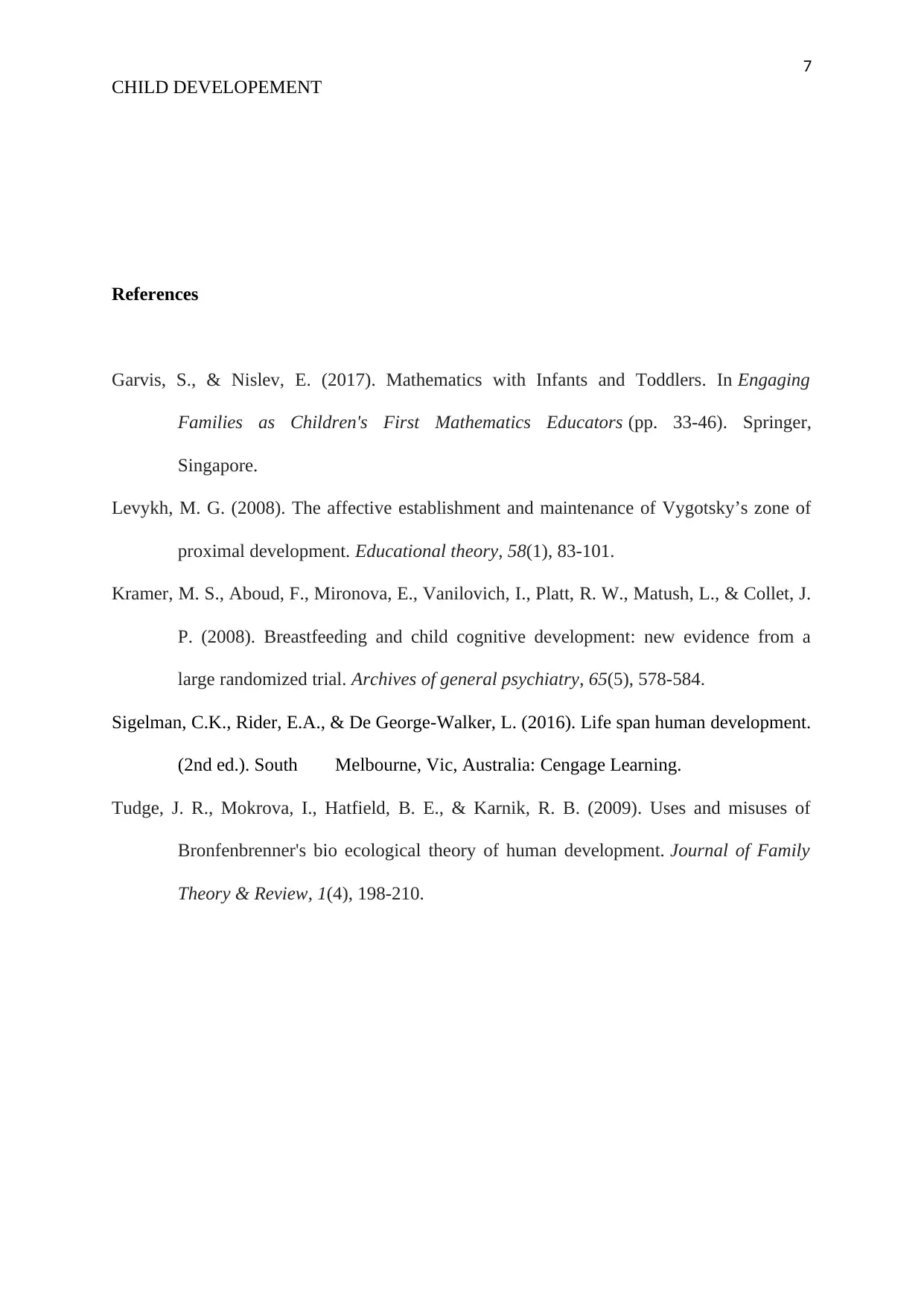
7
CHILD DEVELOPEMENT
References
Garvis, S., & Nislev, E. (2017). Mathematics with Infants and Toddlers. In Engaging
Families as Children's First Mathematics Educators (pp. 33-46). Springer,
Singapore.
Levykh, M. G. (2008). The affective establishment and maintenance of Vygotsky’s zone of
proximal development. Educational theory, 58(1), 83-101.
Kramer, M. S., Aboud, F., Mironova, E., Vanilovich, I., Platt, R. W., Matush, L., & Collet, J.
P. (2008). Breastfeeding and child cognitive development: new evidence from a
large randomized trial. Archives of general psychiatry, 65(5), 578-584.
Sigelman, C.K., Rider, E.A., & De George-Walker, L. (2016). Life span human development.
(2nd ed.). South Melbourne, Vic, Australia: Cengage Learning.
Tudge, J. R., Mokrova, I., Hatfield, B. E., & Karnik, R. B. (2009). Uses and misuses of
Bronfenbrenner's bio ecological theory of human development. Journal of Family
Theory & Review, 1(4), 198-210.
CHILD DEVELOPEMENT
References
Garvis, S., & Nislev, E. (2017). Mathematics with Infants and Toddlers. In Engaging
Families as Children's First Mathematics Educators (pp. 33-46). Springer,
Singapore.
Levykh, M. G. (2008). The affective establishment and maintenance of Vygotsky’s zone of
proximal development. Educational theory, 58(1), 83-101.
Kramer, M. S., Aboud, F., Mironova, E., Vanilovich, I., Platt, R. W., Matush, L., & Collet, J.
P. (2008). Breastfeeding and child cognitive development: new evidence from a
large randomized trial. Archives of general psychiatry, 65(5), 578-584.
Sigelman, C.K., Rider, E.A., & De George-Walker, L. (2016). Life span human development.
(2nd ed.). South Melbourne, Vic, Australia: Cengage Learning.
Tudge, J. R., Mokrova, I., Hatfield, B. E., & Karnik, R. B. (2009). Uses and misuses of
Bronfenbrenner's bio ecological theory of human development. Journal of Family
Theory & Review, 1(4), 198-210.
1 out of 7
Your All-in-One AI-Powered Toolkit for Academic Success.
+13062052269
info@desklib.com
Available 24*7 on WhatsApp / Email
![[object Object]](/_next/static/media/star-bottom.7253800d.svg)
Unlock your academic potential
© 2024 | Zucol Services PVT LTD | All rights reserved.
